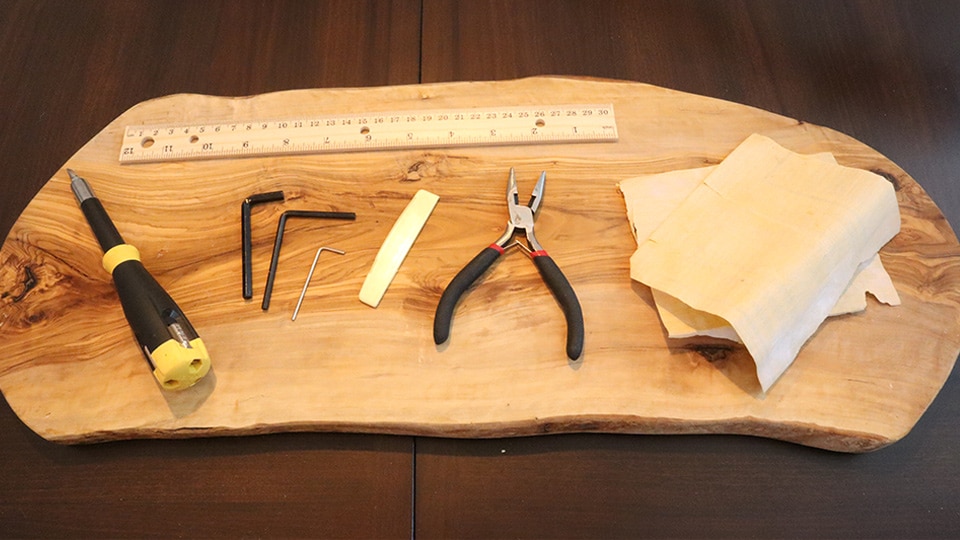Picture this: you've ordered a guitar or bass as a gift to share the joy of music with a loved one this holiday season. Before the main event, the guitar arrives, and you unbox it to make sure everything looks good before bringing it to its grateful recipient. You know enough about playing the instrument to be... shall we say... dangerous. And then you notice the problem: the instrument is poorly set up and difficult to play - unsuitable for a beginner. It's the night before you need to gift-wrap it, so taking it to a shop for a proper setup isn't an option. What do you do? The good news is that there are several setup hacks you can do using tools that you likely already own. To get started, you'll need a screwdriver, a set of allen keys, a ruler, pliers, and some sandpaper. Bonus points for a fresh set of strings and a string winder. Let's dive in!
![[RS+] - Guitar Setup Tricks - guitarcat](http://staticctf.ubisoft.com/J3yJr34U2pZ2Ieem48Dwy9uqj5PNUQTn/520jiE2i8yUJglmu7GaNER/332c77e80b889111f9d91f3dac8d07e4/guitarcat.png)
Let the cat help you. The cat will show you more than you ever knew. The cat's name is Shark. This is the cat tax.
Tighten up loose parts
Just like anything you might send through the mail, parts can rattle loose in-transit. While you can make do with some loose nuts and bolts on a new guitar, eventually these loose parts will strain solder joints and break wires, so tighten them up. Also pay attention to small details like strap buttons if the guitar has them. A slightly loose strap button will eventually become a very loose strap button, and finally become a guitar crashing to the floor. Keep that process in check!
![[RS+] - Guitar Setup Tricks - Cursory Adjustments](http://staticctf.ubisoft.com/J3yJr34U2pZ2Ieem48Dwy9uqj5PNUQTn/702UcyNqsZwkixxr4v6E2I/050504a7689986a8eb1f1540479efd83/cursoryadjustments.png)
Regular maintenance keeps your beloved instrument ready to play.
Change the strings
If you've purchased a used instrument - or one that's been at the store for a while - check the state of the strings. Even if they haven't been played much, old strings can become corroded and lose their tone. If the guitar doesn't sound as good as you remember, it's probably time for a change. A fresh set of strings is one of the most affordable hacks you can do to improve your tone and playing experience, whether it's on a new-to-you guitar or one you've had for years. A string change is also a great opportunity to clean hard-to-reach areas of the guitar. In addition, it's a considerate touch to make sure a beginning player has a completely fresh start.
Tune it up
Start with an instrument that is in tune, so you know what you're working with. Bringing strings up to pitch adds tension to parts of the guitar that otherwise might come loose or behave differently without. Getting your instrument as close as you can to a real-life playing setup before you begin making changes (unless of course there's obvious damage that would worsen) gives you a better chance you have of making thoughtful adjustments.
Adjust the action
Now, down to business! If the guitar is still hard to play after a string change, it's time to look at the action - the distance between the strings and the fretboard - to see if it needs an adjustment. Start by sighting down the neck toward the body of the guitar to make sure there's nothing wrong with the neck. A little bit of relief (a curve) is okay - and even desirable, but too much makes it hard to press the strings down and can lead to other problems with intonation and fret buzz. In practice, the neck should look nearly straight.
![[RS+] - Guitar Setup Tricks - Neck Relief](http://staticctf.ubisoft.com/J3yJr34U2pZ2Ieem48Dwy9uqj5PNUQTn/2rsAka696R4H77T9dGFsf1/b1100649361c694184871deef3ca9678/neck_relief.png)
Look for a slight bend in the neck like this one, but not too much. Some relief makes the guitar easier to play; too much gets in the way.
If nothing looks amiss with the neck, measure the distance between the bottom of the strings and the top of the frets. Depending on what kind of guitar you're working on - and personal taste - these measurements may vary a little, but there is a range where most players feel comfortable. Measure the distance between the top of the twelfth fret (the double dot) and the bottom of the string. A good ballpark range is 1.5 mm (on the thinnest string) to 2.4 mm (on the thickest string) for an electric guitar, 2 mm - 2.8 mm for an acoustic, 2 mm - 2.5 mm for a four-string bass, and as much as 3 mm - 4 mm for a nylon-string classical guitar. Different manufacturers also make their own recommendations, so if you're not sure what's ideal for your instrument check the builder's website for more specifics.
![[RS+] - Guitar Setup Tricks - Neck Relief - String Height](http://staticctf.ubisoft.com/J3yJr34U2pZ2Ieem48Dwy9uqj5PNUQTn/1q6Tk7HatVeLEK6uf0kN8W/7021c49cf855165709c319013de070eb/String_height.png)
You get to decide what's right for you based on your preferences and your specs, but this isn't for you - what does the new player in your life need?
Let's say the action is too high, meaning there's too much of a gap between the strings and the frets. There are a couple ways to fix that. First, circle back to the curvature of the neck. If the neck is too bowed, you can tighten the truss rod to help straighten it a little. A truss rod is a piece of metal that runs the length of the neck. By changing how much tension it puts on the wood, you can change how much relief the neck has. Your instrument likely arrived with an allen key or similar tool for this purpose. Sometimes the access point for the truss rod is on the headstock; sometimes it's on the body. If you need to straighten a neck with too much relief, turn the nut clockwise. If you need more relief on the neck, turn it counterclockwise. You may have heard that a bad truss rod adjustment can damage the neck. This is true, so be careful and take your time. Make small fractions of a turn at any given time and check your progress frequently. If you make small adjustments and aren't over-zealous about how much you tighten the nut, your guitar will be fine.
![[RS+] - Guitar Setup Tricks - Trussrods](http://staticctf.ubisoft.com/J3yJr34U2pZ2Ieem48Dwy9uqj5PNUQTn/12ZmvkkAhhYgnmbp7h9pOX/19fd66c2670cae2f682b382fccf8bc57/trussrods.png)
Different guitar brands will put the truss rod access at different places; wherever it is, the process is the same: Left loosens; right tightens. This is the gift.
If the neck looks straight but the action is still too high, it's time to move on to the bridge. For electric instruments, it's usually a simple task to raise and lower the action at the bridge, using either an allen key or a screwdriver. Again, make small adjustments and check your work as you go. Don't forget to check your tuning as you make these adjustments - you'll be surprised how much even a small change can affect your strings.
![[RS+] - Guitar Setup Tricks - Bridge Height](http://staticctf.ubisoft.com/J3yJr34U2pZ2Ieem48Dwy9uqj5PNUQTn/KC7aGERDbBwzthcdQrZsc/d1bff979697b124335df5dda39a4ae50/bridge_height.png)
Your guitar maker has given you the opportunity to make it yours. Or to share it. This is the gift.
For an acoustic guitar this process is trickier, and you'll once again want to work very slowly and carefully since you'll need to sand down the bottom of the bridge, that is, the piece of bone or plastic that the strings rest on when they meet the body of the guitar. With the strings off, the bridge should pop out of the saddle - the wood part - pretty easily. Put some sandpaper on a flat surface and slowly and carefully sand some of the material off. Take your time and check your work frequently. It's better to go slow and need to repeat the process than to take too much material away at the beginning and not be able to put it back.
![[RS+] - Guitar Setup Tricks - Bridge Sanding](http://staticctf.ubisoft.com/J3yJr34U2pZ2Ieem48Dwy9uqj5PNUQTn/76YYuHNecRmAO292NqCngb/d80d40725513e892a790d57a98fa13f1/bridgesanding.png)
Work slowly and carefully; you can do this!
Do what you can and then find an expert
When in doubt, take the instrument to a pro. If you buy a guitar from a local shop, someone on staff likely is skilled at guitar setups and can offer one at a reasonable fee. It's good to remember that guitars often are set up to ship, not to play, when they leave the factory or the seller. One of the best things you can do - especially if you're shopping online - is to educate yourself about what you can do with the skills and tools you have on hand to save time, headaches, and potentially, money when an instrument arrives at your doorstep.
Take this article as your encouragement to get started; there are tons of detailed resources and specialized tools out there. A lot of these tasks are also part of regular guitar maintenance so don't be afraid to make these adjustments yourself; just be sure to do your homework. Think of it like working on your car - you need to know what you're doing, but you CAN learn to do it, and there's a lower barrier to entry than it may seem at first glance. Learning to do this work empowers you to have the best experience every time you play, fix issues on the fly, share your love of music, and build confidence as you go. Happy gifting, and happy holidays!
Margaret Jones is a multi-instrumentalist, songwriter, and music teacher living in Oakland, CA. She plays guitar in several local bands including her own songwriting project M Jones and the Melee. She also holds a Ph.D. in Music History from UC Berkeley and has taught at the San Francisco Conservatory of Music.
The photos are the author's own. The cat is the author's own. Enjoy the ride and take it in stride.









